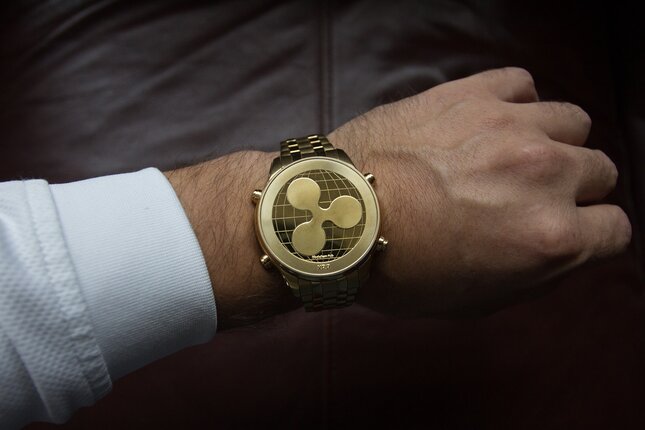- EUR/USD trades marginally higher in the European session on Thursday.
- Sellers could be discouraged in case the pair stabilizes above 1.0800.
- Weekly Initial Jobless Claims and preliminary October PMI will be featured in the US economic docket.
After closing the third consecutive day in negative territory on Wednesday, EUR/USD holds its ground and clings to small gains near 1.0800 early Thursday. Once the pair stabilizes above this level, sellers could be discouraged, paving the way for an extended recovery.
Euro PRICE This week
The table below shows the percentage change of Euro (EUR) against listed major currencies this week. Euro was the weakest against the US Dollar.
| USD | EUR | GBP | JPY | CAD | AUD | NZD | CHF | |
|---|---|---|---|---|---|---|---|---|
| USD | 0.62% | 0.67% | 1.72% | 0.04% | 0.75% | 0.67% | 0.21% | |
| EUR | -0.62% | -0.02% | 0.99% | -0.52% | 0.10% | -0.06% | -0.50% | |
| GBP | -0.67% | 0.02% | 1.03% | -0.63% | 0.09% | 0.00% | -0.51% | |
| JPY | -1.72% | -0.99% | -1.03% | -1.66% | -0.95% | -0.97% | -1.55% | |
| CAD | -0.04% | 0.52% | 0.63% | 1.66% | 0.63% | 0.69% | 0.04% | |
| AUD | -0.75% | -0.10% | -0.09% | 0.95% | -0.63% | -0.01% | -0.61% | |
| NZD | -0.67% | 0.06% | 0.00% | 0.97% | -0.69% | 0.00% | -0.51% | |
| CHF | -0.21% | 0.50% | 0.51% | 1.55% | -0.04% | 0.61% | 0.51% |
The heat map shows percentage changes of major currencies against each other. The base currency is picked from the left column, while the quote currency is picked from the top row. For example, if you pick the Euro from the left column and move along the horizontal line to the US Dollar, the percentage change displayed in the box will represent EUR (base)/USD (quote).
The broad-based US Dollar (USD) strength forced EUR/USD to stay on the back foot midweek. The USD benefited from the risk-averse market atmosphere and received an additional boost from rising US Treasury bond yields on Wednesday.
Early Thursday, the data from Germany and the Eurozone both showed that the business activity in the private sector contracted at a softening pace in early October. The preliminary HCOB Composite PMI for Germany improved to 48.4 from 47.5, while the Composite PMI for the Eurozone edged higher to 49.7 from 49.6.
Assessing the PMI surveys' findings, “for the European Central Bank (ECB), the latest figures come with an unwelcome surprise. Inflation in the services sector seems likely to stay elevated, as costs and selling prices in October rose faster than the previous month," said Dr. Cyrus de la Rubia, Chief Economist at Hamburg Commercial Bank and added:
"All this backs the idea that the ECB is likely to cut key interest rates by just 25 basis points in December, rather than the 50 basis points some have been talking about.”
In the second half of the day, the US economic calendar will feature the weekly Initial Jobless Claims and S&P Global PMI data. In case the number of first-time applications for unemployment benefits rise toward 250,000, the USD could come under bearish pressure with the immediate reaction. On the other hand, if the Composite PMI comes in near September's reading of 54, the USD could stay resilient against its peers.
EUR/USD Technical Analysis
The upper limit of the descending regression channel coming from late September aligns as immediate resistance near 1.0800. The 20-period Simple Moving Average (SMA) on the 4-hour chart reinforces this level as well. Once the pair flips that level into support, it could extend its recovery toward 1.0850 (50-period SMA) and 1.0900 (round level, static level).
If EUR/USD fails to clear 1.0800, technical sellers could look to retain control. In this scenario, 1.0770 (mid-point of the descending channel) and 1.0730 (lower limit of the descending channel) could be seen as next support levels.
Euro FAQs
The Euro is the currency for the 19 European Union countries that belong to the Eurozone. It is the second most heavily traded currency in the world behind the US Dollar. In 2022, it accounted for 31% of all foreign exchange transactions, with an average daily turnover of over $2.2 trillion a day. EUR/USD is the most heavily traded currency pair in the world, accounting for an estimated 30% off all transactions, followed by EUR/JPY (4%), EUR/GBP (3%) and EUR/AUD (2%).
The European Central Bank (ECB) in Frankfurt, Germany, is the reserve bank for the Eurozone. The ECB sets interest rates and manages monetary policy. The ECB’s primary mandate is to maintain price stability, which means either controlling inflation or stimulating growth. Its primary tool is the raising or lowering of interest rates. Relatively high interest rates – or the expectation of higher rates – will usually benefit the Euro and vice versa. The ECB Governing Council makes monetary policy decisions at meetings held eight times a year. Decisions are made by heads of the Eurozone national banks and six permanent members, including the President of the ECB, Christine Lagarde.
Eurozone inflation data, measured by the Harmonized Index of Consumer Prices (HICP), is an important econometric for the Euro. If inflation rises more than expected, especially if above the ECB’s 2% target, it obliges the ECB to raise interest rates to bring it back under control. Relatively high interest rates compared to its counterparts will usually benefit the Euro, as it makes the region more attractive as a place for global investors to park their money.
Data releases gauge the health of the economy and can impact on the Euro. Indicators such as GDP, Manufacturing and Services PMIs, employment, and consumer sentiment surveys can all influence the direction of the single currency. A strong economy is good for the Euro. Not only does it attract more foreign investment but it may encourage the ECB to put up interest rates, which will directly strengthen the Euro. Otherwise, if economic data is weak, the Euro is likely to fall. Economic data for the four largest economies in the euro area (Germany, France, Italy and Spain) are especially significant, as they account for 75% of the Eurozone’s economy.
Another significant data release for the Euro is the Trade Balance. This indicator measures the difference between what a country earns from its exports and what it spends on imports over a given period. If a country produces highly sought after exports then its currency will gain in value purely from the extra demand created from foreign buyers seeking to purchase these goods. Therefore, a positive net Trade Balance strengthens a currency and vice versa for a negative balance.
Information on these pages contains forward-looking statements that involve risks and uncertainties. Markets and instruments profiled on this page are for informational purposes only and should not in any way come across as a recommendation to buy or sell in these assets. You should do your own thorough research before making any investment decisions. FXStreet does not in any way guarantee that this information is free from mistakes, errors, or material misstatements. It also does not guarantee that this information is of a timely nature. Investing in Open Markets involves a great deal of risk, including the loss of all or a portion of your investment, as well as emotional distress. All risks, losses and costs associated with investing, including total loss of principal, are your responsibility. The views and opinions expressed in this article are those of the authors and do not necessarily reflect the official policy or position of FXStreet nor its advertisers. The author will not be held responsible for information that is found at the end of links posted on this page.
If not otherwise explicitly mentioned in the body of the article, at the time of writing, the author has no position in any stock mentioned in this article and no business relationship with any company mentioned. The author has not received compensation for writing this article, other than from FXStreet.
FXStreet and the author do not provide personalized recommendations. The author makes no representations as to the accuracy, completeness, or suitability of this information. FXStreet and the author will not be liable for any errors, omissions or any losses, injuries or damages arising from this information and its display or use. Errors and omissions excepted.
The author and FXStreet are not registered investment advisors and nothing in this article is intended to be investment advice.
Recommended Content
Editors’ Picks

EUR/USD holds steady above 1.0800, looks to post weekly losses
EUR/USD trades marginally higher on the day above 1.0800 after the data from the US showed that Durable Goods Orders declined by 0.8% in September. Nevertheless, the pair remains on track to close the fourth consecutive week in negative territory.

GBP/USD extends recovery to 1.3000 area
GBP/USD extends its recovery and trades at around 1.3000 in the American session on Friday. The US Dollar struggles to gather strength as the market mood remains positive heading into the weekend, allowing the pair to hold its ground.

Gold fluctuates in narrow range below $2,750
Gold stays in a consolidation phase and fluctuates in a relatively tight range below $2,750 on Friday. US Treasury bond yields stabilize in the American session, making it difficult for XAU/USD to gather directional momentum.

Crypto Today: XRP, Bitcoin and Ethereum decline as Ripple files response to SEC appeal
XRP loses over 1.30% as Ripple's executive confirms the filing of an important document in the appeals process in the SEC lawsuit. Bitcoin corrects less than 1% and sustains above $67,500. Ethereum is down nearly 0.20%, holding above the key support level of $2,500.

US elections: The race to the White House tightens
Trump closes in on Harris’s lead in the polls. Neck and neck race spurs market jitters. Outcome still hinges on battleground states.

Best Forex Brokers with Low Spreads
VERIFIED Low spreads are crucial for reducing trading costs. Explore top Forex brokers offering competitive spreads and high leverage. Compare options for EUR/USD, GBP/USD, USD/JPY, and Gold.
